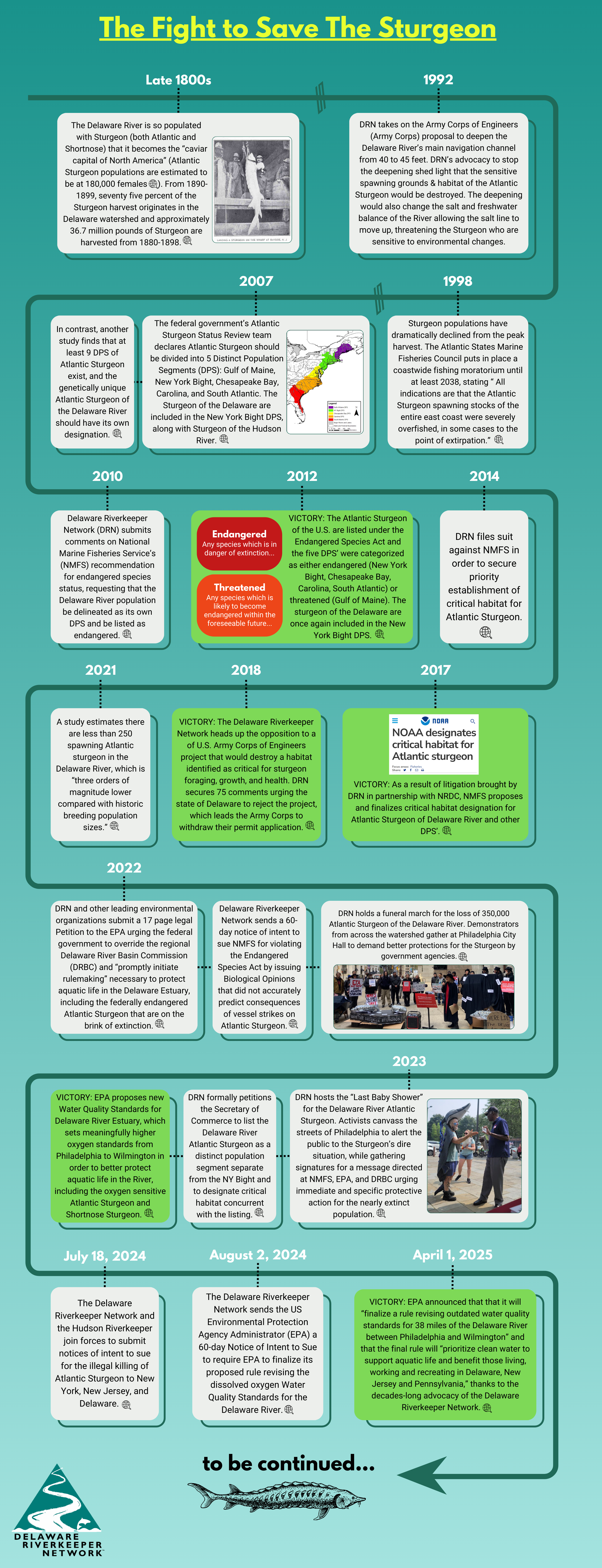Atlantic Sturgeon
Legal Victory for the Endangered Delaware River Atlantic Sturgeon
On July 21, 2025 a federal judge signed off on the Delaware Riverkeeper Network’s Joint Motion for Stipulated Judgment in its lawsuit against the US Environmental Protection Agency (EPA). This judicial order creates a legally binding deadline for EPA to finalize water quality standards for the Delaware Estuary by September 22, 2025.
This agreement has been decades in the making. In 2013, DRN petitioned the Delaware River Basin Commission (DRBC) to issue much-needed upgraded water quality criteria for the Delaware Estuary. When it became clear that the DRBC was failing to protect the health of this stretch of the River, DRN and partners filed a legal petition with the EPA pursuant to the federal Clean Water Act (CWA) and Administrative Procedure Act in April 2022.
In December 2022, the EPA granted DRN’s petition and issued an Administrator’s determination which found that updated water quality standards are necessary to meet the requirements of the CWA. The EPA published proposed water quality standards in December 2023, but failed to publish final standards within the 90-day window required by the CWA. As a result, DRN filed suit in the US District Court for the Eastern District of Pennsylvania in October 2024.
DRN will continue to be a watchdog for this stretch of the River to ensure the new water quality standards are published by the date intended and that the health of the River is improving.
Update 2025-04-01:
The US EPA announced that that it will “finalize a rule revising outdated water quality standards for 38 miles of the Delaware River between Philadelphia and Wilmington” and that the final rule will “prioritize clean water to support aquatic life and benefit those living, working and recreating in Delaware, New Jersey and Pennsylvania.”
This announcement confirmed the dissolved oxygen standards for the Delaware River and Estuary would be delayed from their expected date but would still be issued in a delayed but timely fashion. No exact time line has been issued but the Delaware Riverkeeper Network continues to advocate for the highest possible standards while we await the final rule. Read the full press release HERE
Update 2024-10-24:
Delaware Riverkeeper Network Files Lawsuits Against The States of New York, New Jersey, and Delaware For Failing To Uphold Their Legal Obligations to Protect the Atlantic Sturgeon
On October 24, 2024, Delaware Riverkeeper Network and Hudson Riverkeeper filed suits against the states of New York, New Jersey, and Delaware to address the illegal capture and killing of endangered Atlantic Sturgeon by commercial fishing operations. Commercial fisheries approved and permitted by the three states have caused Atlantic Sturgeon to be caught, harmed, injured, and killed as bycatch. The level of scientifically documented bycatch, as well as a recognition that high levels of bycatch are unaccounted for due to a lack of required monitoring is leaving the future of these ancient creatures in perilous question, according to the organizations.
The two organizations held a press conference to address questions on the filings, which can be viewed here: (New York, New Jersey, Delaware). Read the full press release here.
On July 18, 2024, the Delaware Riverkeeper Network and the Hudson Riverkeeper joined forces to submit notices of intent to sue for the illegal killing of Atlantic Sturgeon to New York, New Jersey, and Delaware. The notices describe how Atlantic sturgeon are being killed in high and unaccounted for numbers without required permitting or approval pursuant to the Endangered Species Act in each of the three states. Read more on the notice here.
Update 2024-10-02:
Delaware Riverkeeper Network Files Lawsuit Against US EPA: Claims Agency’s Delayed Release of Water Quality Standards Essential for Protecting Endangered Sturgeon & Other Aquatic Life Violates the Clean Water Act
On October 2, 2024, Delaware Riverkeeper Network filed a complaint in the U.S. District Court for the Eastern District of Pennsylvania against the US Environmental Protection Agency (EPA) for its failure to finalize dissolved oxygen standards essential for protecting the Delaware River’s endangered population of Atlantic Sturgeon and other aquatic life. The lawsuit was filed after the government was given a 60-day notice of the Delaware Riverkeeper Network’s intent to file the suit if action was not taken to resolve the legal violation. Read the full press release here.
To find out what you can do to help the Atlantic Sturgeon today, visit dinointhedelaware.org.
Background & information
The Delaware Riverkeeper Network has defended the genetically unique population of Atlantic Sturgeon, found only in the Delaware River, for over a decade. We have advocated for the designation of the Delaware River population of Atlantic Sturgeon as endangered and have brought multiple legal actions to ensure that federal and state agencies uphold their obligations to protect this prehistoric species.
The Atlantic Sturgeon has a storied history in the Delaware River watershed.
This prehistoric fish was once an important resource for local Native American tribes with the Delaware River supporting the largest population of Atlantic Sturgeon in North America. Atlantic Sturgeon are a vital part of the River’s ecosystem – past, present, and future.
The National Marine Fisheries Service (NMFS) estimates that historically there were around 180,000 spawning females in the Delaware River population of Atlantic Sturgeon. As a result, the Delaware River gained the title of “caviar capital of North America”. Seventy five percent of the 1890-1899 Sturgeon harvest originated in the Delaware River watershed (Cobb, J. The Sturgeon Fishery of the Delaware River and Bay, Report of Commissioner of Fish and Fisheries (1899).) This frenzied over-harvesting quickly led to a drastic collapse of the River’s Atlantic Sturgeon population.
The Atlantic Sturgeon are facing threats from every angle. Habitat loss from dredging, blasting, and other deepening activities; saltwater intrusion; water pollution and poor water quality; the loss of river bottom habitat needed for spawning from coverage of silt from the coal industry; impingement and entrainment; boat and propeller strikes; and fisheries bycatch have all contributed to the Atlantic Sturgeon’s continued decline and inability to recover from the historic overharvesting. As a result of these devastating and ongoing impacts it is estimated that there are less than 250 spawning adults left of the Delaware River population of Atlantic Sturgeon.
To find out what you can do to help the Atlantic Sturgeon today, visit dinointhedelaware.org.
Our Atlantic Sturgeon are unique
When the Atlantic Sturgeon of the U.S. were listed under the Endangered Species Act in 2012, a Distinct Population Segments (DPS) of Atlantic Sturgeon were identified. Four DPS’ were listed as endangered (New York Bight which includes the Delaware River population, Chesapeake Bay, Carolina, South Atlantic) and the fifth DPS has been listed as threatened (Gulf of Maine). (You can learn more about the various DPS listings here.)
While the New York Bight Distinct Population Segment (DPS) is unique among Atlantic Sturgeon, the Delaware River population of Atlantic Sturgeon are unique among the New York Bight. The Delaware River population of Atlantic Sturgeon contains a genetically distinct haplotype unique to only the Delaware River. Meaning, this population of Atlantic Sturgeon are found nowhere else in the world but in our Delaware River. Unfortunately, this unique population is also in the worst shape; despite a decades-long moratorium on fishing, the population has been largely unable to recover because of the myriad of harmful activities and circumstances discussed above.
Our Work

The importance of protecting the ancient species
The Delaware Riverkeeper Network recognizes the importance of protecting this ancient species, and has been intimately involved in its listing and the development of critical habitat. Since the earliest days of our organization in 1988, the Delaware Riverkeeper Network has been a staunch advocate for the protection of the Delaware River’s genetically distinct population of Atlantic Sturgeon. In October of 2010, DRN submitted comments on NMFS’s recommendation for endangered species status, and in April and June of 2012 DRN wrote NMFS emphasizing the need to establish critical habitat and to protect the Atlantic Sturgeon from the harms of the Delaware deepening project. In March of 2014 DRN filed suit against NMFS in order to secure priority establishment of critical habitat for Atlantic Sturgeon. As the result of a legal settlement of the case, a critical habitat designation for the Delaware River was proposed and finalized, along with critical habitat for other DPS’, in 2017.
The critical habitat designation for the Delaware River population of Atlantic Sturgeon includes the Delaware River from the Route 1 Toll Bridge in Trenton downstream 137 river kilometers to Hope Creek, NJ. This portion of the river is vital to the Atlantic Sturgeon’s recovery as it functions as both spawning grounds for Atlantic Sturgeon and as a migration corridor to and from the Atlantic Sturgeon’s spawning grounds. This section of the Delaware Estuary contains the hard substrate, low salinity, and proper spring and fall temperatures necessary for successful spawning. This section of River is also under past, present and increasing pressures harmful to Atlantic Sturgeon – including, but not limited to, advancement of the Rivers salt line caused by human activities which reduce the geographic scope of the spawning grounds available, dredging, in-river development, increased and ongoing pollution inputs, ship strikes and more. The Delaware Riverkeeper Network had urged that the designation include the Delaware Bay, also critical for the species, but the final designation did not include this portion of the Delaware River system.
Holding government accountable
On more than one occasion, the Delaware Riverkeeper Network has held state and federal agencies accountable for their crimes against the prehistoric fish. We have sent urgent letters and rallied the environmental community on behalf of the Sturgeon, we work constantly to not only educate the public but also involve them in the fight for the Sturgeon.
Whether it be preventing the U.S. Army Corp of Engineers from dumping on critical habitat, urging the National Marine Fisheries Services to protect the species from excessive takes from dredging projects, battling the Salem Nuclear Generating Station for its intake system that kills over 14 billion fish at all stages of life including the Atlantic Sturgeon, or suing state and federal agencies for putting the fish at risk of vessel strike or bycatch (and thus violating the Endangered Species Act), the Delaware Riverkeeper Network has been and continues to be the Atlantic Sturgeons’ #1 advocate.
Raising our voices
The Delaware Riverkeeper Network has led many public awareness campaigns to educate the community on the plight of the genetically unique population of Atlantic Sturgeon of the Delaware River.
In November of 2022, Delaware Riverkeeper Network held a funeral march for the loss of 350,000 Atlantic Sturgeon of the Delaware River. Over 50 demonstrators, including activists, Indigenous leaders, community members, and environmental advocates from across the watershed gathered at Philadelphia City Hall to demand better protections for the Sturgeon by government agencies.
As a continuation of the Atlantic Sturgeon Funeral, in June of 2023, Delaware Riverkeeper Network hosted the “Last Baby Shower for the Delaware River Atlantic Sturgeon”. Over the course of the two day event, activists and volunteers canvassed the lawns of Independence Hall and the streets of Philadelphia to alert the public once again to the Sturgeon’s dire situation, while at the same time gathering signatures for a message directed at the National Marine Fisheries Service (NMFS), US Environmental Protection Agency (US EPA), and Delaware River Basin Commission (DRBC) urging immediate and specific protective action for the nearly extinct population.





